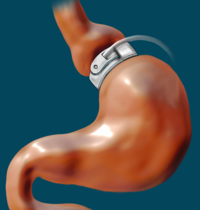
Photo from wikipedia
Background The number of patients with obesity undergoing various surgeries is increasing annually, and ventilation problems are highly prevalent in these patients. Objectives We aimed to evaluate ventilation effectiveness with… Click to show full abstract
Background The number of patients with obesity undergoing various surgeries is increasing annually, and ventilation problems are highly prevalent in these patients. Objectives We aimed to evaluate ventilation effectiveness with pressure-controlled (PC) and volume-controlled (VC) ventilation modes during laparoscopic bariatric surgery. Methods In this open-label randomized crossover clinical trial, 40 adult patients with morbid obesity candidates for laparoscopic bariatric surgery were assigned to VC-PC or PC-VC groups. Each patient received both ventilation modes sequentially for 15 min during laparoscopic surgery in a random sequence. Every 5 min, exhaled tidal volume, peak and mean airway pressure, oxygen saturation, heart rate, mean arterial pressure, and end-tidal CO2 were recorded. Blood gas analysis was done at the end of 15 min. Dynamic compliance, PaO2/FiO2 ratio, P (A-a) O2 gradient, respiratory dead space, and PaCO2-ETCO2 gradient were calculated according to the obtained results. Results The study included 40 patients with a mean age of 35.13 ± 9.06 years. There were no significant differences in peak and mean airway pressure, dynamic compliance, and hemodynamic parameters (P > 0.05). There was no significant difference between the two ventilation modes in pH, PaCO2, PaO2, PaO2/FIO2, dead space volume, and D (A-a) O2 at different time intervals (P > 0.05). Conclusions If low tidal volumes are used during adult laparoscopic bariatric surgery, mechanical ventilation with PC mode is not superior to VC mode.
Journal Title: Anesthesiology and Pain Medicine
Year Published: 2022
Link to full text (if available)
Share on Social Media: Sign Up to like & get
recommendations!